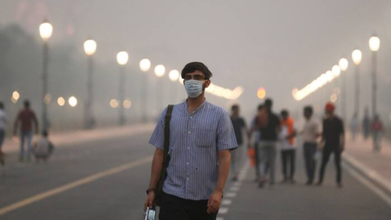- Health Conditions A-Z
- Health & Wellness
- Nutrition
- Fitness
- Health News
- Ayurveda
- Videos
- Medicine A-Z
- Parenting
Is There A Difference Between Zoonotic, Non-Zoonotic And Reverse Zoonotic Diseases

We have all, by now, know that while 2024 was a year disease, but 2025 awaits even more. At the starting of the year only we saw a rise in the cases of bird flu, and saw the virus spread among people too. Then there was trichomoniasis in birds in the UK, and FMD in Germany, and many more. While the source of it all might be animal, not all of these are zoonotic diseases. Not all animal diseases are zoonotic diseases, some are zoonotic, some are non-zoonotic, and some are reverse zoonotic diseases. But, what are the difference?
What Are Zoonotic Diseases?
Zoonotic diseases or zoonoses are infectious diseases that can be spread between animals and humans. It originated with the domestication of animals, animal products or animal derivatives. The word also stems from the Greek word zoion, which means animal, and nosis, which means diseases.
The term was first used in 1885 by Rudolph Virchow in his Handbook of Communicable Diseases. It spreads between vertebrates and humans, which means animals with a backbone, and birds. The way their bodies work is similar enough to ours that pathogens can sometimes adjust to live in both.
While some zoonotic diseases spread only from animals to humans and do not spread from person to person. There are other diseases like Ebola, Mpox, COVID-19, and many more which come from animals, but continue to spread in humans, through humans, and cause outbreaks. Some of them also spread in humans and then mutate to infect only humans, like HIV
Many pathogens are limited to infecting a single type of host—humans, specific animals, plants, or even other microorganisms. However, zoonotic diseases are unique because they can infect both humans and other vertebrates. In some cases, these diseases originally affected only animals, but genetic mutations enabled them to "jump" to humans and cause infections.
Zoonotic illnesses are typically caused by bacteria, parasites, or viruses. However, they can also stem from other sources, such as fungal infections like ringworm or prion diseases like variant Creutzfeldt-Jakob disease (vCJD), often referred to as “mad cow disease.” Animals that carry zoonotic diseases:
- Bats
- Birds
- Cats
- Deer
- Dogs
- Livestock
- Non-human primates, monkeys, apes and chimpanzees
- Rodents
What Are Non-Zoonotic Diseases?
Not all animal diseases are zoonotic. Zoonoses are infectious diseases that can transfer between animals and humans such as rabies, anthrax, influenza, Nipah, COVID-19, brucellosis, and tuberculosis. However, not all animal diseases are zoonotic. Many diseases affect livestock without posing a risk to human health. These non-zoonotic diseases are species-specific and cannot infect humans. Examples include Foot & Mouth Disease (FDM), PPR, Lumpy Skin Disease, Classical Swine Fever, and trichomoniasis in birds and animals.
What Are Reverse Zoonotic Diseases?
It is the case where a disease transmits from humans to animals. This also poses threats to animals health as well as public health, due to the potential for animal disease reservoirs to form.
In 2020, several mink farms in the Netherlands experienced a severe respiratory disease outbreaks, upon investigation, it was revealed that minks had been infected with SARS-CoV-2, the same virus responsible for COVID-19. The minks came in contact with infected farmworkers.
There have been cases when domesticated dogs, cats and ferrets have developed flu-like symptoms caused by influenza A virus, passed on by their owners. Human-derived pathogens also pose significant risks to endangered wildlife. For example, in Tanzania, an outbreak of human metapneumovirus resulted in fatalities among a population of wild chimpanzees. The virus was believed to have been transmitted by researchers and visitors to the national park where the chimpanzees lived, highlighting the potential consequences of human-wildlife interactions.
Top 10 Weird But Medically Valid STI Questions People Asked On Reddit In 2025

Credits: Canva
Public forums often turn into places where people share worries they hesitate to bring up with a doctor. Reddit, especially, saw a surge of unusual yet genuinely important questions about sexually transmitted infections this year in 2025. A large number of these posts came from young adults who felt unsure about new symptoms, confused about how infections spread or overwhelmed by the flood of sexual-health content circulating online.
The ten questions below may seem odd at first glance, but each one raises a medically sensible point. Together, they show how gaps in sexual-health awareness still shape the way people talk about intimacy and illness on the internet.
What Is An STI?
STI refers to a Sexually Transmitted Infection. It is an infection passed through sexual activity such as oral, vaginal or anal contact, and in some cases through non-sexual routes such as blood exposure or mother-to-child transmission.
These infections can be caused by bacteria, viruses or parasites. Some lead to clear symptoms while others remain silent, but untreated cases can result in serious health problems. When an STI begins to cause notable medical issues, it is often described as a Sexually Transmitted Disease (STD).
Top 10 Weird But Medically Valid STI Questions People Asked On Reddit
“Is it possible to get an STI if both people are virgins?”
One user who had only engaged in oral and anal sex with another virgin noticed marks on their legs and wondered if infections could be “passed down by parents.” The spots disappeared on their own, likely due to shaving irritation, yet the question reveals a common misconception. STIs cannot be inherited genetically. They require actual transmission through sexual contact, blood or childbirth.
“Can kissing, a blowjob or rimming spread an STI?”
This question came from someone who had watched too many alarming clips about PrEP and safe sex on social media. They became so uneasy that they avoided going on dates until they understood the risks. Some infections can spread through oral sex and deep kissing, though the degree of risk varies. Their fear felt intense, but the doubt itself was completely reasonable.
“Has anyone in Sri Lanka even had an STI?”
A user in a regional subreddit asked whether STIs even “exist here” because no one talked about them openly. The framing sounded odd, but it reflected the silence that still surrounds sexual health in many places. STIs appear everywhere, though in some communities the subject is rarely discussed.
“What is the real STI risk from a glory hole?”
One of the year’s most unusual but earnest threads came from someone trying to understand whether anonymous sexual setups increase risk. They asked about skin-to-skin contact, bodily fluids and the impact of poor visibility. Though the question seemed strange, experts often point out that uncertainty about partners and surroundings can raise the chance of exposure.
“For people who use glory holes, aren’t you worried about getting an STI?”
Another thread took a more confrontational tone, suggesting that anyone who uses a glory hole “either already has an STD or doesn’t care.” Replies pushed back, saying that anonymity has many motives and that what truly matters is the use of protection and clarity about risk, not assumptions about a person’s character.
“Would I break up with a new partner if they gave me an STI?”
This question was framed like a moral dilemma, but the situation involved real medical timing. A woman had contracted an STI from a partner who had tested too early for the infection to show up on his results. One commenter suggested that the timing hinted at sexual activity very close to the start of their relationship. The discussion blended relationship boundaries with the science of incubation periods.
“I have every symptom under the sun. Is this an STI?”
A worried user described swollen tonsils, tiredness, muscle twitching, stomach cramps, cracking joints, night sweats and more. None of this lined up with any single STI, yet their panic was sincere. The thread showed how anxiety can turn normal bodily sensations into something that feels catastrophic.
“Could I have an STD from giving oral once?”
A person who had their first sexual experience by giving oral sex to an AFAB partner developed painful cracks on their genitals a few days later, even though there was no genital contact. They feared they had caught an infection. While genital cracks from oral contact alone are unlikely, some infections can move through oral-genital routes. Their confusion made sense even if the symptoms did not match the exposure.
“Are these rashes from sex or something else entirely?”
Several users described bumps, redness and irritation, convinced they must have an STI. Many replies explained that chafing, sweat, allergic reactions or grooming habits can look similar to infection symptoms.
“My symptoms came weeks later. Could it still be an STI?”
Some posters were puzzled when new bodily changes appeared long after a sexual encounter. They mentioned stomach issues, headaches or tiredness. While certain infections do have incubation windows, many unrelated issues can appear around the same time, which can lead people to make the wrong connection.
These questions may sound strange, but nearly all came from people trying to understand their bodies and risks. They also show how much sexual-health education remains incomplete. Proper testing, routine medical visits and clear conversations with professionals are still far more dependable than guessing through anonymous internet threads.
Is There Any Link Between Vaccines And Autism? WHO Explains Why Not

Credits: Canva
The World Health Organization (WHO) has reaffirmed that childhood vaccines do not cause autism spectrum disorders (ASD). This follows a fresh review by the WHO’s Global Advisory Committee on Vaccine Safety (GACVS), which examined 31 major studies published between January 2010 and August 2025. Last month, the US Centers for Disease Control and Prevention (CDC) adjusted its website wording, which some argued weakened its earlier, science-backed position that vaccines are not linked to autism. The WHO has now made its stance clear.
Years of research consistently show no causal relationship between vaccinations and autism or other developmental conditions. Robert F. Kennedy Jr., who has long promoted anti-vaccine views, has repeatedly claimed vaccines contribute to autism, despite evidence to the contrary. WHO Director-General Tedros Adhanom Ghebreyesus clarified in a Geneva press conference that vaccines do not cause autism.
WHO Rejects Claims Of Link Between Vaccines And Autism
“Today, WHO is releasing a new analysis by the Global Advisory Committee on Vaccine Safety, which concludes, based on all available evidence, that vaccines are not linked to autism,” said Tedros, as per the official WHO report. The committee reviewed 31 studies conducted across multiple countries over 15 years, looking at vaccines containing thiomersal—a preservative used to prevent bacterial and fungal growth in multi-dose vials—and aluminium adjuvants.
“The review found no evidence connecting vaccines, including those with aluminium or thiomersal, to autism,” Tedros added. “This is the fourth review of its kind, following similar evaluations in 2002, 2004, and 2012, all of which reached the same conclusion: vaccines do not cause autism. Like any medical product, vaccines can have side effects, which WHO monitors carefully, but autism is not one of them.”
What Is Autism Spectrum Disorder?
ASD usually refers to Autism Spectrum Disorder, a developmental condition that affects communication, social skills, and behavior, with a wide range of symptoms. It can also mean Atrial Septal Defect, a congenital heart condition characterized by a hole in the upper chambers of the heart. Context is important: the first is neurological, the second cardiac, according to the CDC.
RFK Jr Blames Vaccines For Causing Autism
Health And Me has previously reported that Robert F. Kennedy Jr., has long claimed that vaccines are responsible for autism. He has cited the rising autism diagnoses over recent decades—from about 1 in 150 children in 2000 to roughly 1 in 36 today—as evidence of vaccine harm. However, multiple studies have debunked this, showing that increased awareness, better screening, and broader diagnostic definitions that include milder forms of autism largely explain the rise. Kennedy’s assertions have been widely criticized by health authorities and autism advocacy groups.
According to the CDC, about half of parents surveyed who have autistic children believe that vaccines may have contributed to their child’s autism. This statistic comes from a 2006 survey published in the Journal of Developmental and Behavioral Pediatrics. The CDC explains that these vaccines are typically those administered within the first six months of life—such as Diphtheria, Tetanus, and Pertussis (DTaP), Hepatitis B (HepB), Haemophilus influenzae type B (Hib), inactivated Poliovirus (IPV), and Pneumococcal conjugate (PCV)—as well as one given at or after the child’s first birthday, the Measles, Mumps, and Rubella (MMR) vaccine.
No Link Between Vaccine And Autism
The supposed connection between the measles, mumps, and rubella (MMR) vaccine and autism originated from a flawed 1998 study, later retracted for using falsified data. Its findings were never replicated and have been thoroughly refuted by extensive research. “The study was shown to be fraudulent and withdrawn, but the notion it created has persisted,” said Tedros.
Kennedy has a long record of promoting questionable claims, which have become central to his “Make America Healthy Again” campaign, a notable element of President Trump’s broader Make America Great Again coalition. The recent CDC website changes sparked concern and alarm among career scientists and public health experts, including those within the agency, who have spent years combating misinformation.
'India Sets Its Own Air Standards,' Says Government, As Delhi Struggles To Breathe Through Toxic Air, 'WHO Guidelines Are Only Advisory'

Credits: ANI
Delhi AQI turns 'very poor' on Friday, with overall Air Quality Index hitting at 331 at 7am. As per the Central Pollution Control Board (CPCB) data, Jahangirpuri was the worst-affected area, and had its AQI at 405, under the 'severe' zone. Reports have shown that PM2.5 or the particulate matter levels in Delhi is well over 30 times the World Health Organization (WHO) safe standard.
However, the Minister of State for Environment Kirti Vardhan Singh said in Parliament that the WHO guidelines are only meant to help nations frame their own standards, factoring in geography, environmental conditions and local circumstances. He said that no global authority conducts official rankings, the government evaluates air quality within the country through its annual Swachh Vayu Survekshan, which ranks 130 cities under the National Clean Air Programme (NCAP) based on improvement efforts.
This was the Centre's response on Thursday to a question in Rajya Sabha on India's stand on IQAIr's World Air Quality Ranking, the WHO Global Air Quality Database, the Environmental Performance Index (EPI), and the Global Burden of Disease (GBD) metrics.
While this was happening in the Parliament, the Central government's 'Air Quality Early Warning System for Delhi' said that "The air quality is likely to be in the Very Poor category from 11.12.2025 to 13.12.2025. The outlook for the subsequent 6 Days: The air quality is likely to be in the Very Poor category.
So, what is to be considered? Is the central government evading India's global air quality rankings? Previously, the union government also denied any deaths directly linked to air pollution.
However, the GBD data found that at least 15% of all deaths in 2023 were related to air pollution. The analysis was based on the data released by the Institute for Health Metrics and Evaluation (IHME). The data estimated around 17,188 deaths in the national capital, all of which were linked to long-term exposure to particulate matter or PM2.5. This means 1 in every 7 deaths in Delhi could be traced to city's toxic air.
Is The Government Doing Anything?
Amid the continuously worsening air condition in Delhi, the government has now formed an 'expert group' to combat air pollution as health crisis rise.
The panel will study how pollution builds up from human activity as well as natural causes and will recommend technology upgrades, policy reforms, and sector specific interventions that can be put into action.
The group will be chaired by retired IAS officer and former Union Environment Secretary Leena Nandan. Other members include former CPCB member secretary Dr JS Kamyotra, IIT Delhi professor emeritus Mukesh Khare, IIT Kanpur professor emeritus Mukesh Sharma, and Dr Suneel Pandey, director of Circular Economy and Waste Management at TERI. Representatives from CAQM, the IMD, APAG, PHDCCI and senior officials from the Delhi government are also part of the group. The Secretary of Environment and Forest is a member, and the DPCC chairman will serve as member secretary.
This expert panel will act as a high level advisory body, offering clear, actionable guidance that can shape both emergency responses and long term reforms. It will track the progress of current pollution control programs, study global best practices, and flag where corrections are needed. The group will meet every month, either in person or virtually, and will receive administrative support from the Delhi Pollution Control Committee. The initial tenure is six months, with the option to extend if required.
What Does Government Data Tell Us About Pollution And Health?
The government revealed that in the span of three years between 2022 to 2024, Delhi's six state run hospitals recorded 200,000 cases of acute respiratory illness. The government also said in parliament that more than 30,000 people were hospitalized in Delhi over three years with respiratory illness.
For weeks Delhi's PM2.5 levels have stayed 20 times the limit recommended by the World Health Organization (WHO). In the span of three years, here is how many case Delhi's six major hospitals have recorded:
- 2022: 67,054
- 2023: 69,293
- 2024: 68,411
"Analysis suggests that increase in pollution levels was associated with increase in number of patients attending emergency rooms. However, this study design cannot provide confirmation that the association is causal," the government told parliament.
© 2024 Bennett, Coleman & Company Limited

